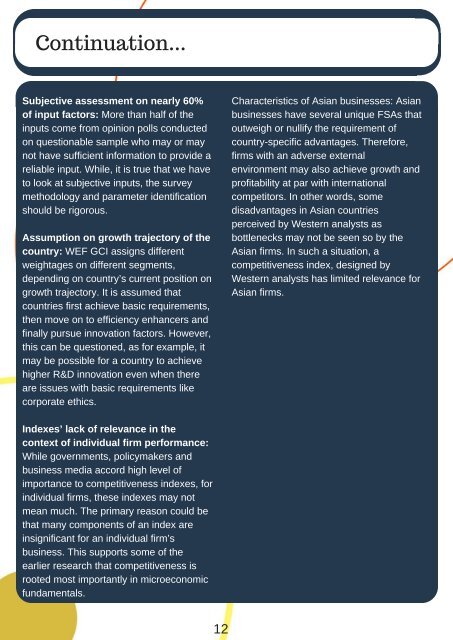Create successful ePaper yourself
Turn your PDF publications into a flip-book with our unique Google optimized e-Paper software.
Continuation...<br />
Subjective assessment on nearly 60%<br />
of input factors: More than half of the<br />
inputs come from opinion polls conducted<br />
on questionable sample who may or may<br />
not have sufficient information to provide a<br />
reliable input. While, it is true that we have<br />
to look at subjective inputs, the survey<br />
methodology and parameter identification<br />
should be rigorous.<br />
Assumption on growth trajectory of the<br />
country: WEF GCI assigns different<br />
weightages on different segments,<br />
depending on country’s current position on<br />
growth trajectory. It is assumed that<br />
countries first achieve basic requirements,<br />
then move on to efficiency enhancers and<br />
finally pursue innovation factors. However,<br />
this can be questioned, as for example, it<br />
may be possible for a country to achieve<br />
higher R&D innovation even when there<br />
are issues with basic requirements like<br />
corporate ethics.<br />
Characteristics of Asian businesses: Asian<br />
businesses have several unique FSAs that<br />
outweigh or nullify the requirement of<br />
country-specific advantages. Therefore,<br />
firms with an adverse external<br />
environment may also achieve growth and<br />
profitability at par with international<br />
competitors. In other words, some<br />
disadvantages in Asian countries<br />
perceived by Western analysts as<br />
bottlenecks may not be seen so by the<br />
Asian firms. In such a situation, a<br />
competitiveness index, designed by<br />
Western analysts has limited relevance for<br />
Asian firms.<br />
Indexes’ lack of relevance in the<br />
context of individual firm performance:<br />
While governments, policymakers and<br />
business media accord high level of<br />
importance to competitiveness indexes, for<br />
individual firms, these indexes may not<br />
mean much. The primary reason could be<br />
that many components of an index are<br />
insignificant for an individual firm’s<br />
business. This supports some of the<br />
earlier research that competitiveness is<br />
rooted most importantly in microeconomic<br />
fundamentals.<br />
12


